Lately I’ve been having a lot of conversations around investment terms with searchers, as well as investors.
About 15 years ago, I interned at a search fund. And, over the last few years, I’ve started to invest in the asset class going direct as well as through funds of search funds.
Investing in search funds is a great way to scratch my entrepreneurial itch, extremely rewarding when a searcher finds success, and can be economically rewarding too.
This post is my attempt to share thoughts on self funded search economics in an effort to contribute to the search fund community, get feedback on my thinking from a wider audience, and of course meet more people who are doing searches/investing and may want to collaborate (please feel free to reach out!).
You can watch a video of me explaining this model here, and download the excel here:

Enterprise Value
The standard finance equation is enterprise value = debt + stock – cash. Enterprise value is how much the company itself is worth. Many times people confuse it with how much the stock is worth and find the “minus cash” part of this really confusing.
So, you can rearrange this equation to make it stock = enterprise value – debt + cash. Make more sense now?
Enterprise value is just how much you’re willing to pay for the company (future cash flows, intellectual property, etc), not the balance sheet (debt and cash).
Most investors and searchers think about the EBITDA multiple of a company on an enterprise value basis because they’ll be buying it on a cash free, debt free basis. It becomes second nature to think about EBITDA multiples and know where a given business should fall given scale, industry, etc.
However, I believe this second nature way of thinking of things can be a massive disadvantage to investors given the way EV and multiples are talked about in our community currently.
Sources of capital, the typical way to calculate enterprise value for self funded searchers
If you’ve ever looked at or put together a teaser for a self funded search deal, you will notice that the deal value is equal to the sum of the sources of capital minus deal fees and cash to the balance sheet.
As a simple example, if there is $4 mm of debt to fund the deal, $1 mm of equity, and $200k of deal fees, the enterprise value = $4 mm + $1 mm – 200k = $4.8 mm.
We’ll use slightly more complex numbers in our example: If a searcher is taking a $3.2 mm SBA loan, $850k seller note, putting in $120k themselves, getting $350k of equity from the seller, a $500k earnout, and $1.2 mm of equity financing minus $350k to the balance sheet and $250k of deal fees, then the enterprise value will be $5.62 mm.
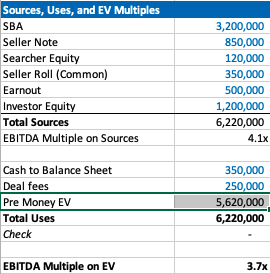
Our example company has $1.5 mm of EBITDA, so the EBITDA multiple is 3.7x. This is a pretty attractive acquisition multiple for a business that meets traditional search criteria (recurring revenues, fragmented competition, high gross margins, low customer concentration, etc).
If you’re seeing a search fund deal for the first time, the headline of “we’re buying a decent company for 3.7x, and replacing a tired owner with a hungry operator” is pretty exciting!
However, if you’re an investor, there is some nuance to this enterprise value number and the true EBITDA multiple you are investing in.
The trick with self funded enterprise value
The security that most self funded search investors get in a deal is participating preferred stock with a paid in kind dividend. This means when there’s an exit, you get your money back before any other equity holder, then get a certain percent of the business, and whatever dividend you’ve been owed in the interim accrues to your principle.
It’s a really favorable security for the investor, and one that is basically impossible to get in VC where straight preferred stock is much more common (no pun intended).
The key terms are what percent of common equity does this security convert into after the originally principal is paid back, and what is the dividend.
The share of common equity the investor group will get typically ranges from 10-50% of the total common stock. The dividend rate is usually 3-15%. The average I’m seeing now is around 30% and 10% for common and dividends respectively.
The strange this about the enterprise value quoted to investors in a teaser/CIM is that it doesn’t change as the percent of common changes, even though this has large implications for how much the common equity is worth and the value investors receive.
For example, I may get a teaser where the sources of investment – cash to balance sheet – deal fees = $3.7 mm for a $1 mm EBITDA company, which would imply a 3.7X EBITDA multiple. Let’s say the searcher is offering investors 30% of the common and a 10% dividend.
Let’s now say that the searcher is having a tough time raising capital and changes their terms to 35% of common and a 12% dividend. Does the effective enterprise value change for investors? I would argue yes, but I would be surprised to see it changed in the CIM/teaser.
This isn’t a knock on searchers or the search fund community. It’s just kind of how things are done, and I think this is mostly because it’s really hard to think about how the enterprise value has changed in this scenario.
However, the natural way of using EBITDA multiples to think about value for a business that is so common in PE/SMB can be extremely misleading for investors here. You may be thinking 3.7X for this type of business is a great deal! But, what if the security you’re buying gets 5% of the common?
If you’re in our world, you may counter this point by saying most searchers will also supply a projected IRR for investors in their CIM. However, IRR is extremely sensitive to growth rate, margin expansion, and terminal value. While the attractiveness of the security will be reflected, it can be greatly overshadowed by lofty expectations.
To get more clarity and have a slightly different mental model on the effective price investors are paying for this business, let’s go back to basics. Enterprise value should be debt + preferred stock + common stock – cash.
We know the values of each of these numbers, except the common. So, the main question here becomes: how much is the common equity worth?
Calculating value of common equity for self funded search funds
Equity value for most search fund deals = preferred equity from investors + the common equity set aside for the searcher and sometimes also advisors, board, seller.
We know that the preferred equity is investing a certain amount for a certain amount of common equity. The rub is that they are also getting a preference that they can take out before any common equity gets proceeds, and they are getting a dividend.
So, the exercise of valuing the common equity comes down to valuing the preference and dividend.
In my mind, there are three approaches:
- The discount rate method where you take the cash flows you’ll get in the future from the pref/dividends and discount them back at the discount rate of your choice. I am using 30% in my model which I believe accurately compensates investors for the risks they are taking in a small, highly leveraged investment run by an unproven operator. If you believe in efficient markets, this number also fits as it mirrors the historical equity returns as reported by the Stanford report, with a slight discount given this asset class has clearly generated excess returns relative to other assets on a risk adjusted basis, hence interest in these opportunities from an expanding universe of investors.
- The second method is to calculate how much money you’d get from your preference and dividends, taking into account that per the Stanford study around 75% of search funds will be able to pay these sums, and then discount these cash flows back at a rate more in line with public equities (7% in my model). This yields a much higher value to the preference/dividend combo, and therefore lowers the implied value of the common equity.
- The last method is to just say nope, there is no value to the preference and dividend. I need them and require them as an investor, but they are a deal breaker for me if they aren’t there, and therefore they don’t exist in my math. This of course makes no logical sense (you need them, but they also have no value?), but I’ve left it in as I think many investors probably actually think this way and it creates a nice upper bound on the enterprise value. Side note, as with obstinate sellers, jerk investors are usually best avoided.
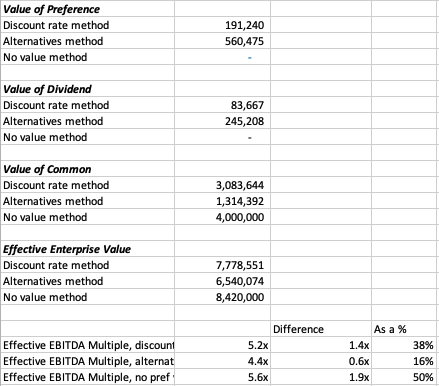
In our example, you can see a breakdown of the preference value, dividend value, and therefore common value and enterprise value for this deal.
In each case, the effective EBITDA multiple moves from 3.7x to something much higher (see the last 3 lines).
There are some simplifying assumptions in the model (no accruing dividend, all paid in last year), and some weird stuff that can happen (if you make the hold time long and the dividend greater than the 7% equity discount rate, the value of the dividend can get really big).
These flaws aside, I think this creates a nice framework to think through what the common is actually worth at close, and therefore what enterprise value investors will be paying in actuality.
It’s worth noting that the whole point of this is to benchmark the value you’re getting relative to market transactions in order to understand where you want to deploy your capital.
This creates a method to translate cash flow or EBITDA multiples of other opportunities on an apples to apples basis (if only there were a magical way to translate the risk associated with each as well!).
Another note, we could calculate the value of the common to be what this asset would trade at market today in a well run auction process minus any obligations (debt, preference, seller financing). However, I think that understates the option value inherent in this equity, a value that is only realized when a new manager takes over with more energy and know how.
There is a finance nerd rational for this. If you plot the value of equity in a leveraged company on a chart, it mirrors the payout of a call option. In both cases, the value of the security increases at a certain inflection point: when the value of equity rises above the strike price in an option, and when the enterprise value of a company rises above the debt level in a levered company.
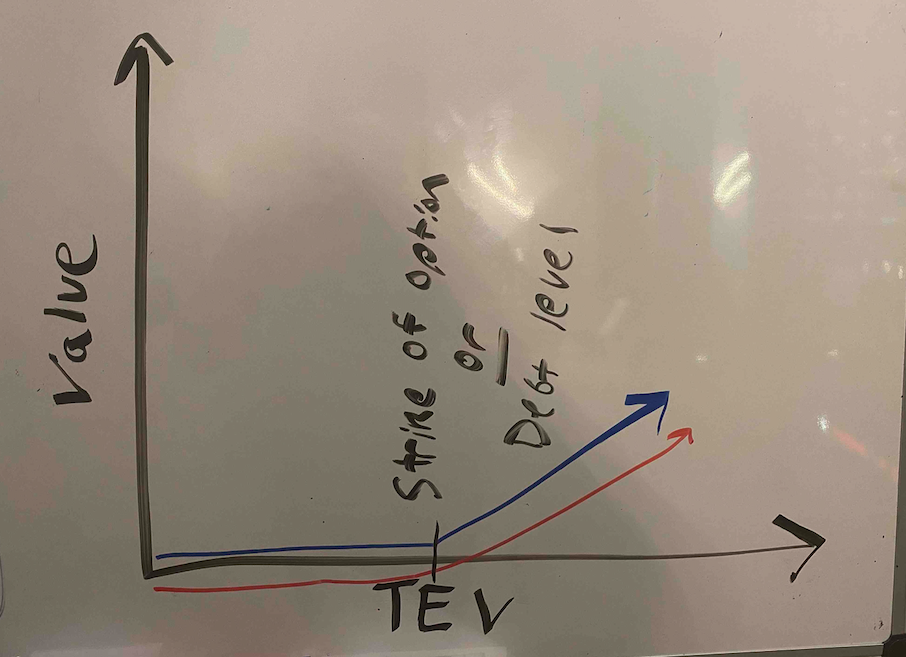
The common equity of a highly levered company can therefore be valued by a similar methodology as the call option: Black Scholes. If you remember back to finance class, increasing volatility will increase the value of an option.
In the search fund case, we’ve (hopefully) increased the (upside) volatility and therefore create more value than simply selling the company today.
A few more thoughts on investor economics
There are a few other ways to think about the economics you get as an investor to best understand if this is the deal for you.
First, you may want to think about how much your investment will be worth day 1. The key lever in this model is what discount this company is being bought for relative to fair market value. For example, the searcher may have proprietary sourced a great company and is buying it for 25% below what it would trade at in a brokered auction.
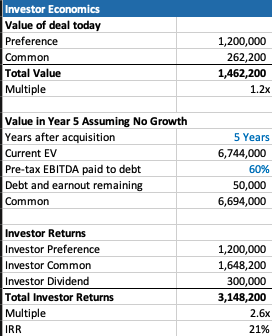
This is very much a “margin of safety” philosophy on things. Same with the calculation on how much you’ll receive in year 5 (after QSBS hits) assuming no growth in the business.
The only problem with each of these calculations is that they never play out in practice. Most companies don’t just stay the same, you’re either in a rising tide or you’re in trouble. And, you’re almost never going to sell in year 1, and definitely not for a slight premium to what it was bought for.
However, if your investment is worth 30% higher day one, and you can make a 20% IRR assuming nothing too crazy happens either way in the business, that’s not a bad place to start. Add in a strong searcher, decent market, some luck, and you’re off to the races.
Thoughts on searcher economics
A lot of this post has considered things from the investor perspective as my main quandary was related to how to create an EBITDA multiple that made sense for investors.
However, the point of this post is not to say searchers are misrepresenting or being unrealistic with their terms. In fact, I think it’s quite logical that self funded searchers capture the massive economic value that they do.
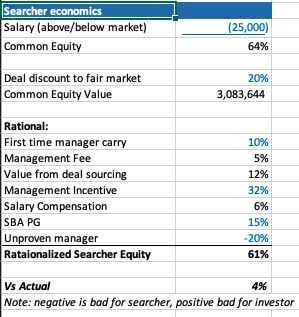
There are many reasons why self funded searchers deserve the lion share of the common equity.
First, they are providing a nice service of giving investors a positive expected value home to park their money with much lower correlation to the market than other asset classes ($1 mm EBITDA companies don’t see lots of multiple contraction/expansion throughout cycles).
Most money managers that fit that criteria are taking a 2/20, of course they also usually have a track record. So, I’ve used a 10% carry in my model, but stuck to 2% annual management fee.
The searcher spent a lot of time, and probably money, finding this company. That’s a lot of value, especially if it’s a below market price. They should be able to capture a lot of the value in finding a below market deal.
The searcher may be taking a below market salary, and needs to get comped like any CEO, with stock options. In my example model I have $1 mm of stock vesting over the hold period, as well as extra comp for taking a below market salary.
Searchers are also usually putting their financial standing at risk by taking a personal guarantee on the bank/SBA loan. This is really tough to put a number on, as is the last line in my framework where searchers are dinged for lack of experience. Like any good model, you need a few lines that you can fudge to make the math work 🙂
What you do think?
I’m shocked that I wrote all this. I was going to type a few paragraphs and a quick excel. However, putting this to paper has been a great exercise for me to sharpen my thinking.
Now I’d like you to help me further. Where do you think this should be changed in this framework? How do you think about things from the investor and/or searcher side?
Feel free to shoot me a note if you have thoughts (even just to tell me I’m being way too academic with this, which I actually agree with).
Lastly, a post like this is really a trap I’m putting on the internet to catch any like minded people in so that we can figure out ways to collaborate now or in the future. So, at the very least, connect with me on LinkedIn 🙂
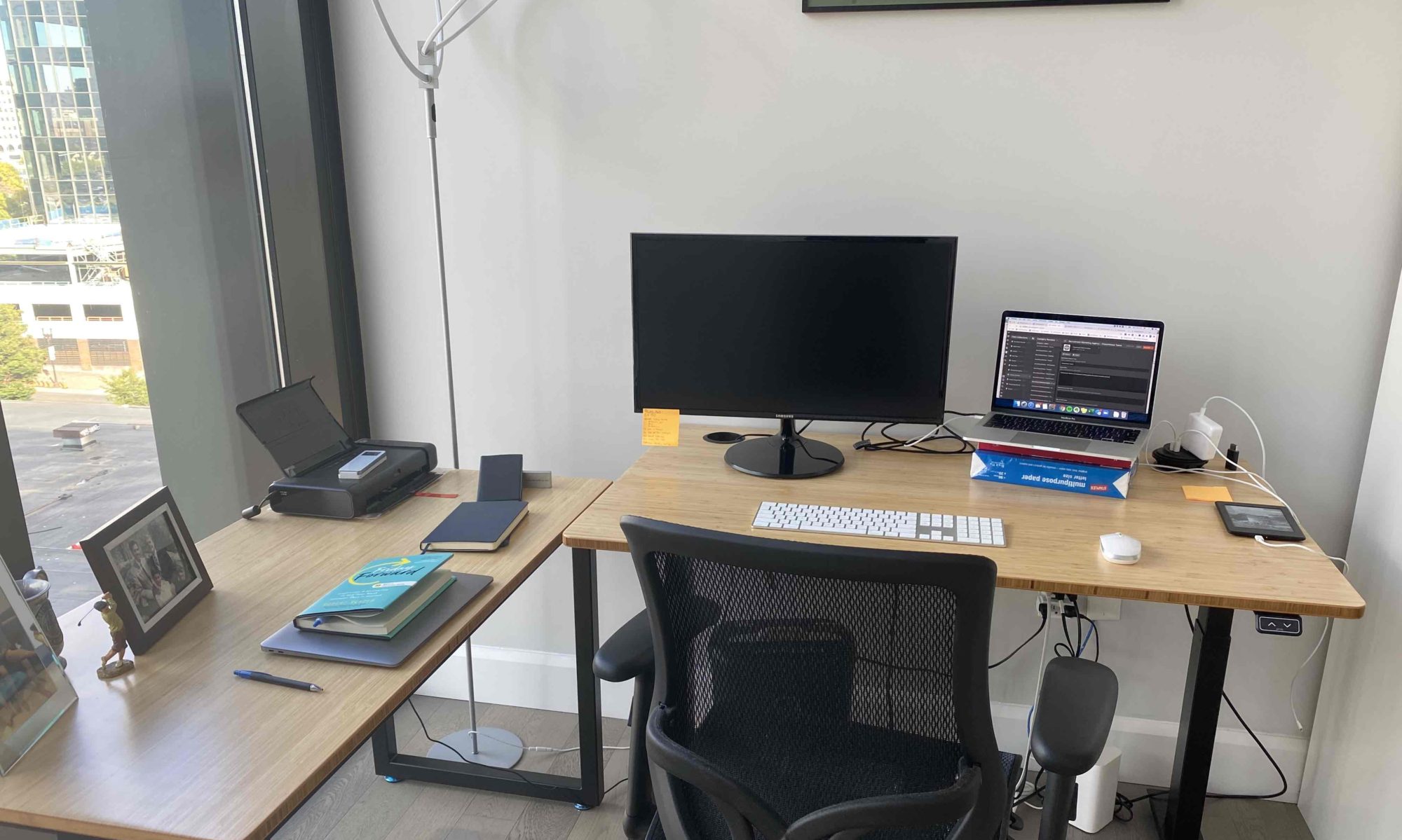
Paragraph writing is also a fun, if you be familiar with then you can write or else
it is complex to write.
Have you ever considered about including a little bit more than just
your articles? I mean, what you say is valuable and
everything. Nevertheless think of if you added
some great images or videos to give your posts more, “pop”!
Your content is excellent but with images and video clips, this blog could
certainly be one of the greatest in its field. Great blog!
This is the perfect webpage for everyone who wants to find out about this topic.
You know so much its almost tough to argue with you (not that I actually will need to…HaHa).
You definitely put a fresh spin on a subject which has been written about for a
long time. Wonderful stuff, just wonderful!
Hi there I am so happy I found your blog, I really found you
by error, while I was researching on Bing for something else,
Anyhow I am here now and would just like to say thanks for a
marvelous post and a all round entertaining blog (I also love the theme/design), I don’t have time to look over it all at the
moment but I have saved it and also added your RSS feeds, so when I have time I will be back
to read much more, Please do keep up the superb work.
excellent issues altogether, you just won a new reader. What might you recommend about your post that you
made some days in the past? Any certain?
I have to thank you for the efforts you have put in penning this site.
I am hoping to view the same high-grade content from you in the
future as well. In truth, your creative writing abilities has motivated me to get my own, personal
blog now 😉
I constantly spent my half an hour to read this webpage’s content all the time along with a cup of coffee.
Howdy just wanted to give you a quick heads
up. The text in your post seem to be running off the screen in Safari.
I’m not sure if this is a formatting issue or something to do with web browser compatibility but I thought I’d post to let you know.
The style and design look great though! Hope you get the issue solved
soon. Many thanks
Thanks for sharing such a pleasant thought, post is fastidious,
thats why i have read it entirely
This is my first time pay a quick visit at here and i am in fact pleassant
to read everthing at one place.
Hello there! Do you use Twitter? I’d like to follow you
if that would be ok. I’m undoubtedly enjoying your blog and look forward to new updates.
I believe that is one of the so much important information for me.
And i am glad reading your article. However wanna observation on some normal things, The web
site taste is wonderful, the articles is truly excellent
: D. Just right process, cheers
I believe that is among the most significant info for me.
And i am satisfied studying your article. But wanna observation on few common things,
The website taste is perfect, the articles is in reality excellent :
D. Just right activity, cheers
Hello to all, it’s genuinely a pleasant for me to visit
this site, it includes useful Information.
Very nice post. I just stumbled upon your blog and wished to say
that I’ve truly enjoyed surfing around your blog posts.
In any case I will be subscribing to your feed and I hope you write again very soon!
Greetings I am so glad I found your web site,
I really found you by mistake, while I was browsing on Aol for something else,
Anyways I am here now and would just like to say many thanks for a tremendous post and a
all round exciting blog (I also love the theme/design), I don’t have time to look over it all at the moment but I have bookmarked it
and also added in your RSS feeds, so when I have time I will be back to read a lot more, Please do keep
up the great job.
Your style is really unique compared to other folks
I have read stuff from. Many thanks for posting when you’ve got the opportunity,
Guess I will just bookmark this page.
of course like your web-site however you need to check the spelling
on several of your posts. Several of them are rife with spelling problems and I to find it very troublesome to tell the truth nevertheless I’ll surely come back again.
In fact when someone doesn’t be aware of after that its up
to other visitors that they will help, so here it takes
place.
Keep on working, great job!
I love what you guys tend to be up too. This sort of clever work and coverage!
Keep up the terrific works guys I’ve added you guys to my blogroll.
Great info. Lucky me I found your website by accident (stumbleupon).
I have saved as a favorite for later!
certainly like your website but you need to check the spelling on several of your posts.
Several of them are rife with spelling issues and I find it very bothersome to tell the truth
then again I’ll definitely come again again.
Usually I do not learn article on blogs, however I would like
to say that this write-up very compelled me to try and do it!
Your writing style has been amazed me. Thank you, very nice article.
Awesome blog! Do you have any tips and hints
for aspiring writers? I’m hoping to start my
own blog soon but I’m a little lost on everything. Would you advise
starting with a free platform like WordPress or go for a paid option? There are so many options
out there that I’m totally overwhelmed .. Any suggestions?
Many thanks!
Yesterday, while I was at work, my cousin stole my iPad and tested
to see if it can survive a twenty five foot drop, just so she can be a youtube sensation. My
iPad is now broken and she has 83 views. I know this is totally off topic but I had to share
it with someone!
Very good post. I definitely love this site. Keep writing!
At this time I am going away to do my breakfast, once
having my breakfast coming yet again to read further news.
Your style is really unique in comparison to other people I’ve read
stuff from. Thanks for posting when you have the opportunity, Guess I’ll just book mark this
page.
I’ve been surfing online more than 3 hours as of late,
yet I never found any attention-grabbing article like yours.
It’s lovely value sufficient for me. Personally, if all webmasters and bloggers made just right content material as you probably
did, the net shall be a lot more useful than ever
before.
Greetings from Ohio! I’m bored at work so I decided to check
out your site on my iphone during lunch break. I really like the knowledge you
provide here and can’t wait to take a look when I get home.
I’m surprised at how fast your blog loaded on my mobile ..
I’m not even using WIFI, just 3G .. Anyhow, excellent blog!
Wow, incredible blog format! How long have you been blogging for?
you made running a blog glance easy. The overall glance of your site is magnificent, as neatly as the content!
I’m curious to find out what blog platform you are utilizing?
I’m having some minor security issues with my latest site and I’d like to find something
more safeguarded. Do you have any recommendations?
I think this is among the most significant information for me.
And i’m glad reading your article. But wanna remark on some general things, The website style
is perfect, the articles is really great : D. Good job, cheers
You made some decent points there. I checked on the internet
to find out more about the issue and found most people will go along with your views on this web site.
If you want to obtain a good deal from this piece of
writing then you have to apply these methods to your won webpage.
Wow that was unusual. I just wrote an really long comment but after I clicked submit my comment didn’t appear.
Grrrr… well I’m not writing all that over again. Anyways, just
wanted to say excellent blog!
Outstanding story there. What occurred after? Good luck!
Link exchange is nothing else however it is simply placing the
other person’s website link on your page at suitable place and other person will also
do similar in favor of you.
Hi there! Quick question that’s totally off topic.
Do you know how to make your site mobile friendly?
My website looks weird when viewing from my iphone4. I’m trying to find a theme or plugin that might
be able to fix this issue. If you have any suggestions,
please share. Many thanks!
Je mag ook waardebonnen of drankmunten uitgeven.
Magnificent beat ! I wish to apprentice at the same time as you
amend your web site, how can i subscribe for a weblog site?
The account aided me a appropriate deal. I were a little bit
familiar of this your broadcast provided bright transparent concept
If some one wishes expert view on the topic of running a blog after that i recommend him/her to pay a visit
this weblog, Keep up the fastidious job.
Hi there every one, here every one is sharing these familiarity,
therefore it’s nice to read this web site, and I used
to visit this website every day.
Have you ever thought about creating an e-book or guest authoring on other sites?
I have a blog centered on the same information you discuss and would really like to have you
share some stories/information. I know my subscribers would value your work.
If you’re even remotely interested, feel free to shoot me
an email.
Thanks designed for sharing such a nice thought, post is
fastidious, thats why i have read it entirely
Everything is very open with a really clear explanation of the issues.
It was truly informative. Your site is very helpful. Thanks for sharing!
I’m truly enjoying the design and layout of your blog.
It’s a very easy on the eyes which makes it much
more pleasant for me to come here and visit more often. Did you hire out a developer to create your theme?
Outstanding work!
I am actually grateful to the owner of this web page who
has shared this impressive post at here.
Pretty! This was an extremely wonderful post.
Thanks for providing this info.